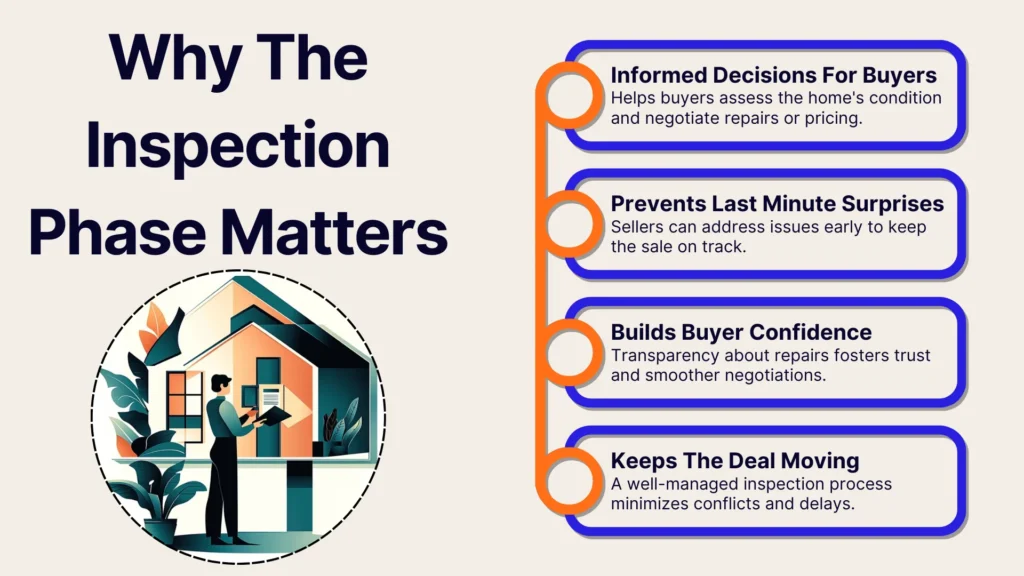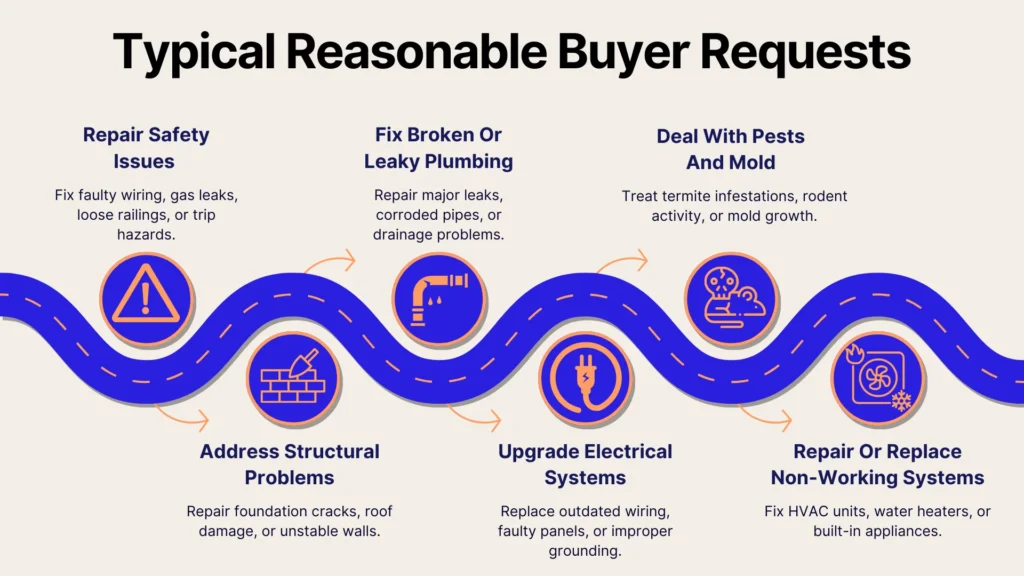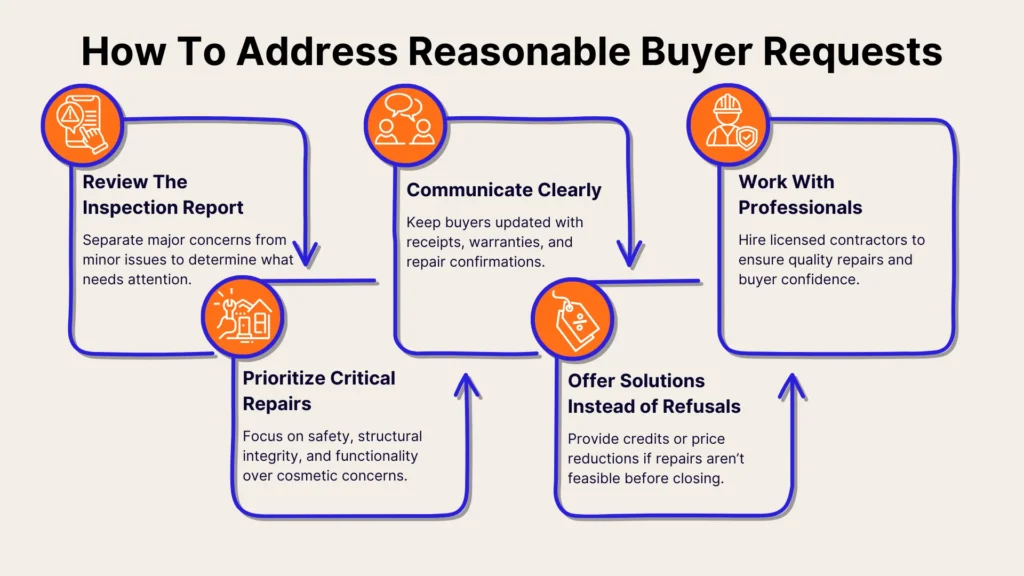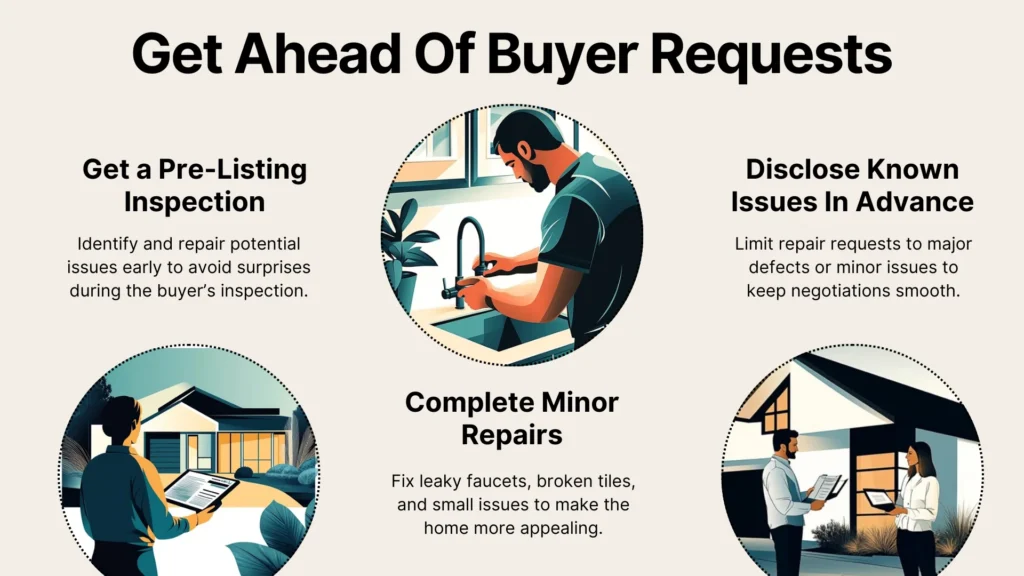Buying a home is one of the biggest financial decisions a person can make, and ensuring that the property is in good condition is a fundamental part of the process. While no home is perfect, inspections often reveal various issues that need to be addressed.
Understanding what qualifies as a reasonable buyer request can make the negotiation process smoother for you and the buyer. This guide will explore common requests that buyers can make after a home inspection, how you can effectively address these concerns, and steps you can take to minimize post-inspection demands.
Understanding the Role of a Home Inspection
A home inspection acts as a checkpoint in the home-buying process, helping buyers assess the property’s condition beyond its surface appeal. It provides insight into potential repairs and maintenance needs, giving buyers the chance to address concerns before committing to the purchase.
By understanding what a home inspection entails and why it matters, buyers can make more informed decisions while you can prepare for reasonable repair requests.
What Is a Home Inspection?
A home inspection is a thorough examination of a property's structure, systems, and components conducted by a licensed inspector. The inspector assesses various aspects of the home, including the foundation, roof, electrical and plumbing systems, HVAC, and more. The goal is to identify existing or potential issues that could impact the home's safety, functionality, or value.
Why the Inspection Phase Is Critical

The inspection phase allows buyers to make informed decisions about moving forward with the purchase. If the inspection uncovers major problems, buyers can request repairs, negotiate pricing adjustments, or, in extreme cases, reconsider their offer.
For sellers, addressing concerns promptly can prevent last-minute surprises that might derail the sale. Additionally, understanding the significance of the inspection process can foster a smoother negotiation between you and the buyer, ensuring that both parties reach an agreement without unnecessary conflict.
Common Types of Reasonable Buyer Requests

After reviewing the inspection report, buyers may submit repair requests. While you aren’t obligated to address every issue, reasonable requests focus on safety hazards, structural integrity, and essential home functions.
Understanding what constitutes a reasonable request will help you avoid unrealistic demands and enables you to respond appropriately without feeling overwhelmed.
Repairs for Safety Issues
Buyers often prioritize repairs related to safety risks, such as faulty wiring, gas leaks, or missing smoke detectors. These issues can pose significant dangers, so requesting their resolution is reasonable. Addressing safety concerns can also benefit you by preventing future liability.
Additionally, unsafe stair railings, unstable decks, and improperly secured water heaters are common safety concerns that should be addressed to create a secure living environment for future occupants. Loose handrails, cracked sidewalks that present trip hazards, and malfunctioning garage doors that pose injury risks are additional concerns that buyers may justifiably request to be remedied.
Addressing Structural Problems
Foundation cracks, roof damage, and compromised load-bearing walls fall under structural concerns. If the inspection reveals problems that could impact the home's stability, buyers may request professional repairs to prevent long-term issues. Structural integrity is one of the most critical aspects of a home's value, so addressing these concerns early can help prevent more severe and expensive damage in the future.
Other issues that may necessitate repair requests include sagging floors, bowing walls, or evidence of prior foundation movement that has not been properly addressed. Unstable retaining walls or improperly installed support beams could also be of concern to buyers seeking reassurance about the home’s durability.
Resolving Plumbing or Electrical Issues
Functional plumbing and electrical systems are essential for a home’s usability. Buyers may ask you to fix major leaks, outdated or unsafe electrical wiring, or drainage problems. While minor issues like a dripping faucet might not warrant a request, significant concerns should be addressed. Properly functioning plumbing and electrical systems contribute to the long-term habitability of a home, reducing the likelihood of future breakdowns or safety hazards.
Issues like corroded pipes, outdated aluminum wiring, inadequate electrical grounding, and improperly vented gas lines are examples of reasonable requests. If the home’s electrical panel is outdated and insufficient for modern electrical demands, buyers may also ask for an upgrade to prevent overloading circuits in the future.
Pest and Mold Remediation
A home inspection may uncover termite infestations, rodent activity, or mold growth. These issues can damage the home and pose health risks. Buyers often request professional remediation services to address infestations or mold removal before finalizing the purchase. Mold, in particular, can cause respiratory problems and long-term damage to a home's interior, making its removal a high-priority issue in real estate negotiations.
Additional pest concerns may include carpenter ants, evidence of bat or bird nesting in the attic, or infestations of roaches or other insects that could compromise the home’s cleanliness. Addressing these issues promptly can prevent further deterioration and mitigate potential health risks for future occupants.
Repairing or Replacing Non-Functional Systems
Non-working HVAC units, broken water heaters, or malfunctioning appliances that are included in the sale often lead to reasonable repair requests. If a major system is completely inoperable, buyers may ask for a repair or replacement to avoid unexpected expenses after moving in. A home with a properly functioning HVAC system and water heater ensures year-round comfort and energy efficiency, making these repairs a practical consideration for both you and the buyer.
Other reasonable requests include fixing broken sump pumps, ensuring that septic systems are properly maintained, and replacing outdated thermostats that no longer function efficiently. Additionally, if a home includes built-in appliances such as dishwashers or refrigerators that are non-functional, buyers may request repair or replacement to ensure that all promised amenities are in working order upon move-in.
How Sellers Can Address Reasonable Buyer Requests

Once a buyer submits their list of requests, you must decide how to respond. The approach should balance addressing legitimate concerns while keeping negotiations productive. Here’s how you can strategically and flexibly approach requests to prevent prolonged disputes and make the transaction smoother:
Step 1: Review the Inspection Report
Start by carefully reviewing the inspection report to understand the identified issues. Not all findings require immediate attention, so it’s important to separate legitimate problems from minor maintenance suggestions.
Consulting with a contractor can help clarify which items need to be addressed. You should also consider how repairs might impact the property's marketability and overall value.
Step 2: Prioritize Critical Repairs
Focusing on major issues that affect safety, functionality, and structural integrity makes negotiations smoother. While cosmetic concerns like chipped paint or worn carpet may not warrant action, addressing foundational cracks or outdated electrical panels can prevent the deal from falling apart.
Step 3: Offer Solutions Instead of Refusals
If you are unwilling or unable to complete repairs, offering alternatives can keep the transaction moving forward. Providing a credit or price reduction allows buyers to handle repairs after closing. This approach can be a lifesaver when time constraints make completing repairs impractical.
Step 4: Work with Professionals
For repairs that you agree to handle, hiring licensed contractors ensures quality work and provides buyers with peace of mind. Properly completed repairs also reduce the risk of post-sale disputes or future legal issues.
What’s more, professional repairs enhance the overall credibility of the seller, demonstrating a commitment to maintaining the home's condition.
Step 5: Communicate Clearly
Keep buyers informed about repair progress to foster trust and minimize misunderstandings. Providing receipts, warranties, or proof of completed work reassures buyers that the home is in good condition, making the final stages of the sale more seamless.
Remember: clear communication helps maintain a positive relationship between you and the buyer, ultimately leading to a successful and satisfactory closing process.
How to Proactively Minimize Buyer Requests

Taking a proactive approach before listing your home can help reduce repair requests and make the selling process smoother. By addressing potential concerns early, you can avoid drawn-out negotiations and boost buyer confidence. Here’s how you can do it:
Conduct a Pre-Listing Home Inspection
Having your home inspected before listing allows you to spot and fix potential issues in advance. This can prevent surprises during the buyer’s inspection and lead to a more straightforward sale. A pre-listing inspection also helps set clear expectations and provides documentation that reassures buyers about the property's condition.
Complete Minor Repairs Before Listing
Taking care of simple repairs like fixing leaky faucets, replacing broken tiles, or patching drywall can make a home more appealing. Addressing minor issues before showings can reduce buyer concerns and limit the number of requests after inspection.
Disclose Known Issues Upfront
Transparency about known defects builds trust and helps buyers make informed decisions. If for whatever reason, you choose not to fix certain problems, disclosing them in advance prevents them from becoming deal-breaking issues later. Proactive disclosure fosters goodwill and reduces the likelihood of contentious negotiations after the inspection.
Price the Home Appropriately
Setting a fair asking price that reflects the home’s condition can make buyers more willing to accept minor defects. If a home needs significant work, adjusting the price accordingly can prevent excessive repair demands. A well-priced home attracts serious buyers and reduces the likelihood of prolonged negotiations over repair costs.
Conclusion
Navigating post-inspection requests doesn’t have to be stressful. Whether you’re buying or selling, being prepared and open to fair solutions makes the process smoother. Addressing issues quickly, offering flexible resolutions, and maintaining clear communication can lead to a successful and stress-free closing.
These tips can smoothen handling buyer requests, but what about other aspects of the home selling process? Consider simplifying other steps with Propbox. PropBox helps you manage the entire process, automating, organizing, and simplifying your sales so you can sell faster and for more while keeping full control. Start selling with PropBox today and take control of your home sale!
